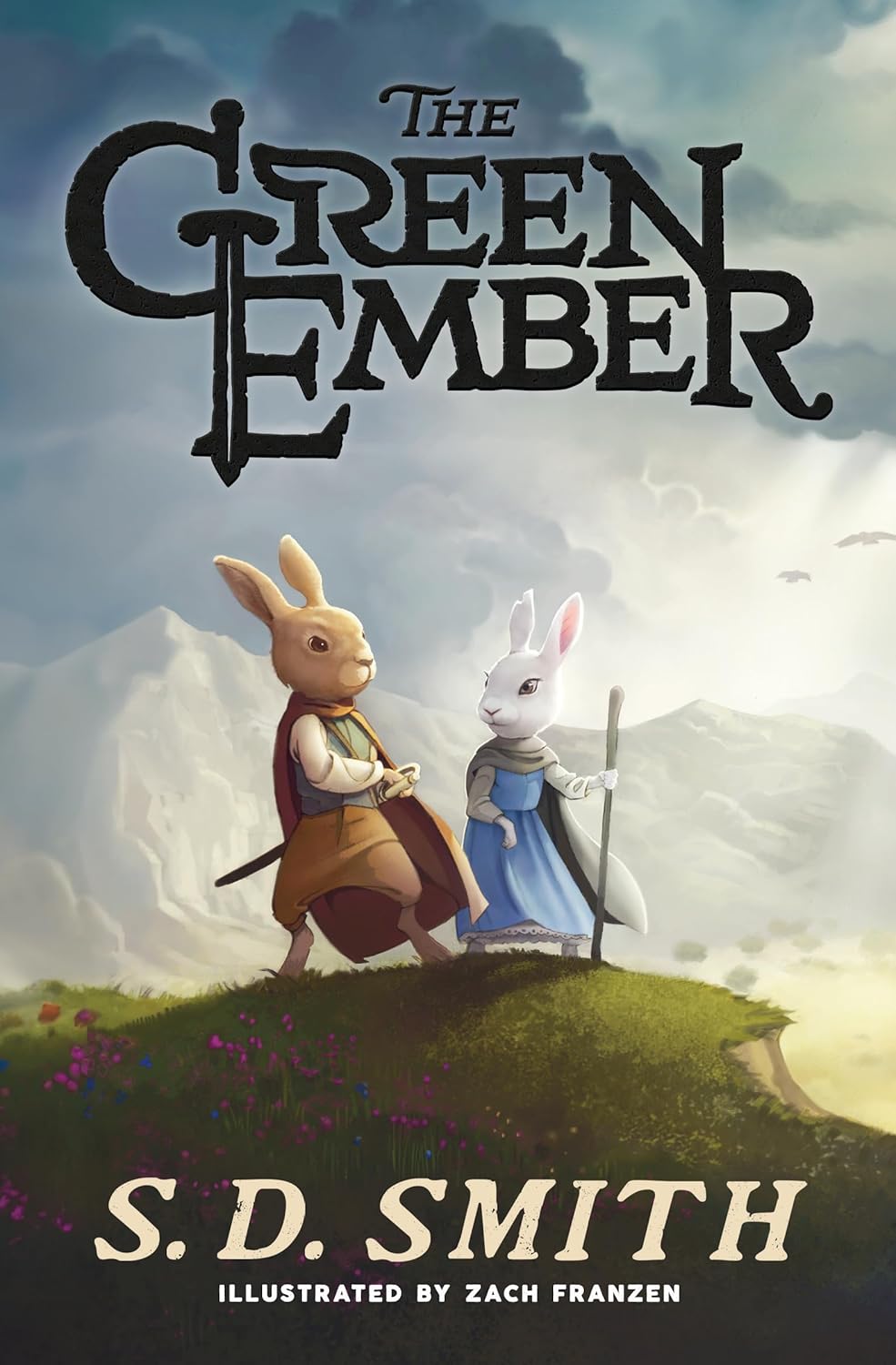Parents or teachers whose concerns include finding safe literature for their brood of voracious young rabbits might wish to consider S. D. Smith’s The Green Ember series. Redwall it is not, but this quadrilogy offers a morally harmless adventure featuring talking bunnies with swords, which, like Brian Jacques’ better-known series, unfolds in a grounded universe with an epic fantasy feel but with little actual magic.
Heather and Picket Longtreader are brother and sister rabbits whose pastoral existence is turned upside-down when the war between good rabbits and an evil alliance of wolves and birds comes for their family, separating them from their parents and younger brother. Rescued by Uncle Wilfred and a rabbit named Smalls, Heather and Picket change from frightened adolescents into major players in the battle to rescue the land of Natalia from its predatory oppressors. There’s a fair amount of battle, political intrigue, lore, and even romance in this epic tale about hope, heroism, and loyalty. Smith slowly builds up his world’s culture, geography, and history, and connects those elements to his characters’ present struggles.
Readers are introduced to a variety of cities and strongholds over the course of four books—along with a large cast of characters, some good, some evil, and some flawed but striving to be better. Though not explicitly religious, the series’ moral framework is traditional and Christian, and there’s no attempt to introduce moral grayness, nor to insert postmodern pseudo-morality or political correctness into the story. While good characters occasionally make bad decisions, these are presented as failures in prudence whose natural consequences our protagonists must endure. The good rabbits in this story battle to achieve their vision of the Mended Wood, a politically just and peaceful social order such as once obtained under the good King Jupiter. Meanwhile, evil characters work through brute force, betrayal, and moral compromise, to establish and maintain dystopian systems of control. Naturally, the enemy seems to be holding all the cards. For this reason, the books’ central theme is one of hoping-against-hope. All that is to the good, but in storytelling, execution is more than half the battle.
While the series’ overarching plot and themes are basically sound, the books’ dialog, characterization, and prose left this reviewer disappointed. Every good character is either spunky or grave, and there’s a tendency for characters to start speaking in the same style as the narrative voice, as if they were mere extensions of the story’s themes rather than living agents. The narrative is at times characterized by an overuse of modifiers, weird point-of-view shifts, breathless melodrama, and a certain redundancy—either for emphasis or for alliteration—that this reviewer found incredibly irritating. These examples are typical:
“It’s a terrible gamble, but she must go,” Mrs. Weaver said, pulling the cloak more tightly around her shivering shoulders. “It’s a risk she must take.”
He had all but outrightly defied Emma’s insistent order for him to spend a few days at rest, angrily arguing with her so loudly that her staff and court were alarmed.
“Thank you for loving us, [spoiler omitted]. Thank you for preparing us for the unnumbered dangers we’ve faced. We had no idea when you gave us the light you did, you were guiding us to one day strike out at the darkness so fiercely. We have been far from flawless, but we have made a hard dart at the darkness. We’ve seen cracks forming and the light seeping in.” She took a deep breath, let it out slowly, then leaned back in her chair.
[Spoiler omitted] gazed at her, mouths open, expressions caught between wonder and unbelief. Tears fell down the fur of their faces, but they didn’t look at all sad. They eyed one another, and shook their heads slowly.
I also found Picket to be something of a Mary Sue, changing from whiny and weak to confident and uncommonly skilled as the plot required, whereas Heather’s character development was more believable. Not wishing to bash the author, whose motives seem good, I’ll leave my critique at that. Ultimately I found the books morally wholesome, very imaginative, and likely to retain a child’s interest, but not always very readable. I was rarely able to enter that state-of-mind where story reigns and one forgets that one is reading a book.
That these books were not to this reviewer’s taste does not mean they aren’t worth recommending. Many readers will be able to overlook the issues mentioned above, and young children in particular are likely to find the world of Natalia imaginative and engaging. The author’s large fanbase proves that he has at least done his primary job as a writer: he’s told a story that engages his target audience. Parents can also rest assured that there’s nothing scandalous, insidious, or problematic in the series’ four main titles—unless of course one considers slaying tyrannical baddies in self-defense to be “problematic,” though I doubt anyone in the author’s target audience will have this hangup.
Reader reactions can be very subjective. Given this series’ reputation, I was expecting a lot more than what I got. However, while perusing through online reader reviews, I found that for every reader whose criticisms resembled my own, there were ten who liked or loved the books, and who were clamoring for more tales set in the world of Natalia. S. D. Smith’s enthusiastic fanbase should therefore be heavily weighted against this reviewer’s personal tastes. Those reviewers do not find the style of prose quoted above off-putting—they think it’s beautiful. If you agree, then you’re likely to enjoy The Green Ember and its sequels.



